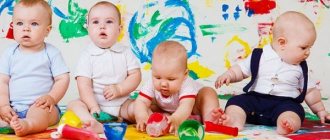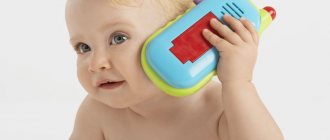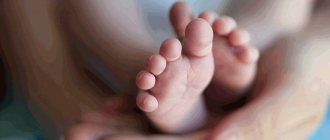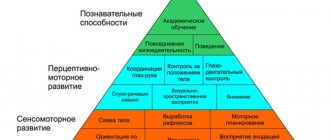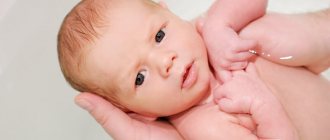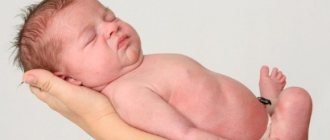Physical development at 12 months of life
During the twelfth month of life, the baby should gain 400 - 350 grams. By the age of one year, the child’s weight increases approximately 3 times.
The child’s body length increases by 1-1.5 cm during this month. Over 12 months of life, the baby’s body length increases by 1.5 times.
The circumference of the chest and head increases by 0.5 cm during the twelfth month of life.
On average, a 1-year-old baby’s height is 75 cm and weight is 10.5 kg.
By the end of the first year of life, a child should have 8 milk teeth.
Neuropsychic development of a child at 12 months
A whole year of life is behind us, the baby is developing comprehensively. The development and improvement of motor skills and speech are actively underway. So what should a child be able to do at 12 months?
Motor development of a child at 12 months
By 12 months, many babies are already taking or trying to take their first steps. Some are already walking independently. They run quickly with the support of an adult.
The baby can stand independently and gets up from a squatting position.
The child can deftly climb onto low objects with the help of stands and can climb up and down steps.
Uses a cup, spoon, sippy cup.
Cognitive development of a child at 12 months
He observes with great interest the hygiene procedures of adults and imitates some of them.
If difficulties arise, the baby can call adults.
At the request of an adult, brings familiar toys or objects. Can grasp several toys with one hand at the same time. May place an object under the armpit to free the hand to grab something else.
At 12 months, a child knows how to use certain objects (putting a phone to his ear, knocking with a hammer, drinking from a cup, etc.).
He distinguishes primary colors well, can assemble a pyramid of 3-4 rings, and build a tower of 2-3 cubes.
Plays simple story games.
Recognizes and shows animals in pictures.
Child's emotional development
- The baby can fulfill simple requests from adults;
- Likes to imitate simple actions of adults;
- Dances to music;
- A sense of humor appears;
- Develops his own manner of behavior with adults;
- At one year old, the baby can distinguish between such concepts as “good” and “bad”, “possible” and “impossible”.
- Shows affection for loved ones and favorite toys;
- Begins to be capricious if he is dissatisfied with something.
Speech development 12 months
At one year old, the baby understands almost everything that is said to him.
By the end of the first year of life, the child’s vocabulary contains 8-15 words, the meaning of which he understands (dai, mom, dad, na, and others). There are also simplified and imitating words (am-am - eat, av-av - dog, tick-tock - clock and others). There are also those that only the child and mother understand.
Daily regime
The child is one year old, which means he will go to kindergarten very soon, so a daily routine will be necessary. It has been proven that children who are accustomed to a strict daily routine adapt more easily to new conditions.
By the age of one year, children's daily routine changes; now, to fully restore their strength, one nap during the day is enough for them.
The daily routine, as well as the nutritional regimen, is the same for a 12-month-old baby and an artificial one:
Caring for a baby at 12 months of age
A one-year-old child still needs daytime sleep, it should be at least 2.5 hours. The duration of night sleep is about 11 hours. It is better to accustom your child to a certain routine, preferably so that he falls asleep and wakes up at the same time.
Hardening procedures are no less important - air and sun baths, rubdowns, douches, walks in the fresh air, water procedures.
A year old, you can bathe your child every other day, the duration of bathing is from 10 to 20 minutes.
Nobody canceled daily hygiene measures either. Every morning, wash your baby, comb his hair, and brush his teeth. Keep your ears and nails clean.
Your baby's routine should include massage and gymnastics. Exercises and techniques become more complex according to the age of the child.
The feeding regimen at 12 months is the same - 5-4 times a day.
Particular attention should be paid to the oral cavity. Dentists recommend starting to brush your teeth from the moment they appear. To care for your first teeth, you can purchase a special toothbrush at the pharmacy.
Physical development: skills and abilities
- by the end of 12 months, children should be able to walk independently;
- the child must be able to get up and do it without parental support;
- at 12 months the baby can run, protected by an adult’s hand;
- Infant vocabulary can range from 10 to 15 words;
- By the end of 12 months of life, a child should know the names of his loved ones, as well as the names of pieces of furniture, toys and frequently used products. If you ask your baby where a certain object or face is, he will correctly point with his finger;
- By the age of one year, children try to be independent in everything;
- By the end of 12 months, the baby will have honed the skills that allow him to drink liquids from a mug and use a spoon tolerably;
- children at 12 months old can assemble a pyramid, roll plasticine sausages in their palms and make cakes from it;
- by the end of the year, children have up to 12 teeth in their mouth;
- the child must be able to chew solid food;
- Some children already know how to ask to use the potty.
By the end of your baby's first year, comparing his development with the successes of his peers, you will notice a big difference. A neighbor's boy may already be able to walk, but he will only have four teeth in his mouth, and a friend's daughter may skip the crawling stage and immediately start walking. Any course of development is the norm, unless a delay in one skill leads to a delay in another.
All babies develop skills on their own schedule, and there is no reason to sound the alarm if your baby's development is slightly off from the norm on the calendar . Consult your pediatrician about everything; he will recommend you do a special course of massage to strengthen the baby’s muscles if he does not want to walk, or prescribe calcium-rich medications if your teeth are not growing well.
Nutrition for a 1 year old child
By the end of the first year of life, you can gradually begin to introduce solid foods into your child's diet. So, you can give a one-year-old baby a piece of apple, a cookie, or a cracker.
Please note that if you give your baby solid food, do not leave it unattended, as the baby may bite off too much and choke.
A child’s diet at 12 months is already very varied; its menu includes basic foods (vegetables, fruits, meat, fish, butter, dairy products, bread and others).
Dairy products are very important in a child's diet. By the end of the first year of life, it is recommended that the baby drinks about 400-500 ml of milk, kefir or yogurt. Milk can be used to prepare porridges and soak cookies in it. Also, the child’s diet should include cottage cheese.
It is better to give meat products to the baby in the first half of the day, so that the digestive system has time to cope with it before going to bed and there are no problems with the tummy.
Once or twice a week, it is recommended to replace meat dishes with fish. For a one-year-old baby, sea fish and non-fatty fish are best suited.
The porridges are very filling and healthy.
To make your baby eat porridge more willingly, you can add vegetables or fruits to it according to your baby’s taste.
Fruits and vegetables are sources of vitamins, minerals and fiber. They must be present in the diet of a one-year-old baby.
It is very useful to give your baby compotes, jelly, and freshly squeezed juices.
Despite the fact that breastfeeding experts recommend breastfeeding your baby until he or she refuses breastfeeding, many mothers begin weaning their baby after a year. Of course, at this age, breastfeeding is more a psychological act than a nutritional element, so you should wean your baby off the breast gradually so as not to injure him.
Thus, by the age of one year, the child has developed a diet consisting of breakfast, lunch and dinner, as well as breast milk or an adapted milk formula.
“You can’t” and “you must”
Mastering walking and speaking does not always go hand in hand. The child seems to lack the strength to succeed in two such difficult areas at the same time. A good walker often lags in words, and a person who quickly gains vocabulary lags behind in walking. Boys usually start speaking later than girls. But among both of them there are stubborn silent people who say very little until one and a half or two years, and suddenly there is a linguistic explosion, a collapse, a gushing of words.
Normally, by the age of one year, a child pronounces 10-15 short words, but understands much more. And in general, he now understands and wants more than he can. Such a gap gives rise to increased capriciousness, fearfulness in some children, and a demand that their mother be constantly nearby. Be patient, know: the more active the child begins to walk, the more he speaks, the calmer he will become.
You can, and should, turn to him with requests like: “Pick up the handkerchief,” “Bring the cube,” “Give me Lala,” “Put down the spoon,” “Open your mouth.”
It’s time to look at children’s books with him, tell him what’s written there, ask: “What is this?”, “Who is this?” He knows how to show where the eyes, nose, and ears are on himself, on mom, and dad, and is capable of some generalizations - he knows that the living cat Murka, the toy cat, and the one drawn in a book are all “kitty-kitty.” He recognizes a well-known person in the photograph and laughs joyfully after making this discovery.
When dressing, undressing, and going to bed, he tries to be not only the object of your actions, but also an active participant. This desire must be supported and directed. Tell him: “Raise your arms,” “Turn around,” “Let’s pull on the tights.” In the process of such partnership and cooperation, speech develops better and faster.
You have already managed to feel the character of your baby - whether he is flexible, calm, affectionate, or obstinate, willful, persistent. This is largely due to innate properties, and they are very stable. It is impossible to “break off”, to transform, say, an obstinate, impulsive stubborn person, to raise him to be an obedient quiet person, unless at the cost of developing his neurosis. Yes, and it would cost you a lot of nerves. So don't set yourself such a task. The wisdom of upbringing lies elsewhere: to open, support, develop everything good in a child and correct, soften, muffle everything undesirable.
The child is not as simple as he seems. Sometimes it seems that he is already studying you, trying out different models of behavior.
"On the!" - He hands you his worn-out cracker and looks inquisitively. Be sure to take it, say “thank you,” and praise it for your kindness. "Bang!" - He throws the spoon onto the floor with a flourish and again looks inquisitively. Make a stern face, shake your head sadly, show him in every possible way that you are upset and dissatisfied.
Among the words and concepts that a child must learn, there are two key, most important ones: “you can’t” and “you must.” In essence, a person’s moral education and his future life attitudes are based on them. In the meantime, they protect the baby’s safety and help him better navigate the world around him, which is now becoming more and more open to him.
Both teachers and doctors are unanimous that there should not be too many prohibitions. This does not give the desired results, rather the opposite.
In everything that is permissible, yield to the child; what is really forbidden, strictly prohibit. This rule lasts for a long time, throughout childhood. But if you can explain to the elder why it’s not possible, it’s better to switch the baby, distract him from the forbidden.
He became adept, for example, while sitting in his grandmother’s arms, tearing off her glasses and even throwing them.
"It is forbidden!" - you tell him. Didn't listen? You can just lower him to the floor - this is punishment. There is another option: try to switch, rebuild the mischievous gesture into an affectionate one. Your hand reaches out to your glasses frame, grab it, say: “Adjust grandma’s glasses, kiss, stroke grandma...”
Or the baby gets to the book and tears it up. "It is forbidden!" - you say sternly and take it from him. And in return, bring, for example, pictures on thick cardboard - you won’t tear them, but you can sort them out and look at them. It’s good for such cases to have in stock a few things that are attractive to the baby, which he rarely sees, to show him something unexpected. In the language of physiology, this is called “creating a new focus of excitation.”
Or: the child does not like to wash himself, is capricious, and breaks out. “We must, we must,” you say affectionately, while you make the water warmer and use your hands more carefully. And after washing, combing your hair, take you to the mirror: “Look how clean and beautiful you are.” Children usually look in the mirror with great interest, although at this age they do not yet really perceive themselves, and this interest can soften and smooth out the impression of the troubles they have just experienced.
In general, your tactics should be flexible, there are many options for compromise. The main principle is to try to ensure that every “no” is contrasted with an alternative “possible”, and every “must” is carried out in the least burdensome way for the child.
Necessary examinations of a child at 1 year
A routine examination by a pediatrician is required every year to assess the child’s physical and neuropsychic development.
It is also necessary to visit a number of specialized specialists: a neurologist, a surgeon, an ophthalmologist, an orthopedist, an otorhinolaryngologist (ENT doctor), and a dentist.
Take a series of tests: a general blood test, a general urine test, a general stool test (scatology), a stool test for worm eggs.
According to the national calendar of preventive vaccinations, people are vaccinated against measles, mumps and rubella every year.
Children are also given the Mantoux test (to detect tuberculosis).

